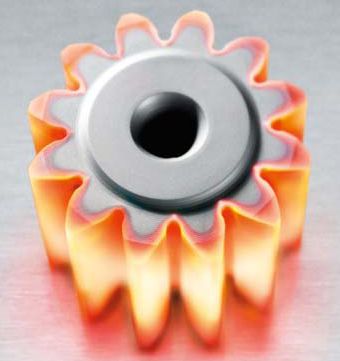German eldec synchronous dual-frequency induction hardening to obtain balanced contour hardening layer technology
Germany's Eldec synchronous dual-frequency induction hardening technology is widely applied in various industries, including the automotive sector, mold production, aerospace manufacturing, and electrical and mechanical equipment such as generators and transformers. This advanced technique is particularly effective for components with complex surface geometries.
**SDF Contour Quenching Technology**
For workpieces with irregular surfaces like gears, traditional single-frequency induction heating often fails to deliver optimal results. Gears have both convex and concave regions, and using high-frequency induction heating can lead to over-hardening on the gear teeth while under-hardening the root areas. This can increase residual stress at the root, potentially causing cracks. On the other hand, medium-frequency induction heating may result in better hardening at the root but insufficient hardening on the tooth tips. With SDF® (Simultaneous Dual Frequency) technology, both high and medium frequencies are used simultaneously, allowing for uniform heating of the gear’s tooth top and root, resulting in a balanced hardened layer across the entire contour.
SDF® technology works by generating both intermediate and high-frequency currents within a single induction coil. These currents induce eddy currents on the surface of the workpiece, rapidly heating it in just 0.2 to 0.3 seconds before being quickly cooled, achieving precise contour hardening. Key features of SDF® include the use of IGBT transistors, synchronized dual-frequency heating, minimal deformation, accurate contour hardening, high thermal efficiency, and low environmental impact.

**Comparison of Heat Treatment Processes**
Three main quenching methods are compared: carburizing and quenching (contour quenching), single-frequency induction quenching (non-contour quenching), and SDF® (precise contour quenching).
Carburizing and quenching involves heating the workpiece above Ac3 in a carburizing furnace, followed by rapid cooling and tempering to achieve desired mechanical properties. It is suitable for carbon steels with less than 0.25% carbon, such as 5115 (16MnCr5). However, this process leads to high deformation, low energy efficiency, and long quenching times—up to ten hours. Local quenching is also difficult to implement.
Single-frequency induction hardening uses a single frequency to generate eddy currents at the workpiece surface, followed by rapid cooling. It is ideal for carbon steels with up to 0.35% carbon, such as 1040 or 4140 (42CrMo4). While it offers moderate deformation and higher energy efficiency, it may not provide sufficient hardening in all areas, especially in complex shapes.
SDF® technology provides a more precise and efficient solution. It applies both high and medium frequencies simultaneously, ensuring even heating and hardening along the workpiece’s contour. This method minimizes deformation, offers high flexibility, and significantly reduces environmental impact. The quenching time is under 30 seconds, making it highly suitable for local and precise heat treatment.
In addition, modern induction hardening machines are now modular and integrated into production lines, enabling continuous flow operations and boosting overall productivity.
**SDF Technology Applications**
Several leading companies, such as Boeing in the U.S., have adopted SDF induction hardening technology for their gears, including straight bevel (cone) gears, replacing the traditional carburizing and quenching process. This change not only improves product quality but also reduces environmental impact. Many parts no longer require additional machining after heat treatment.
German automakers like BMW, Volkswagen, Audi, as well as global giants such as Bosch and Siemens, have successfully implemented SDF technology. Domestically, numerous enterprises have also adopted this method. After treatment, the hardened layer is uniformly distributed, making it ideal for gears, worms, hypoid shafts, steering gears, CV joints, drive shafts, and other components with complex contours. It is especially effective for parts with diameters of 6mm or smaller, as well as for intricate surface features such as varying hole end faces.
Regulating Flow Sphere,L Type Sphere Ball,Electric Control Ball Valve,Change The Way Ball Valve
Antong Valve Co.,Ltd , https://www.atvalveball.com
